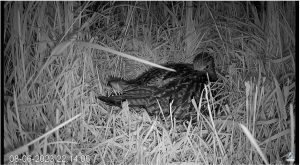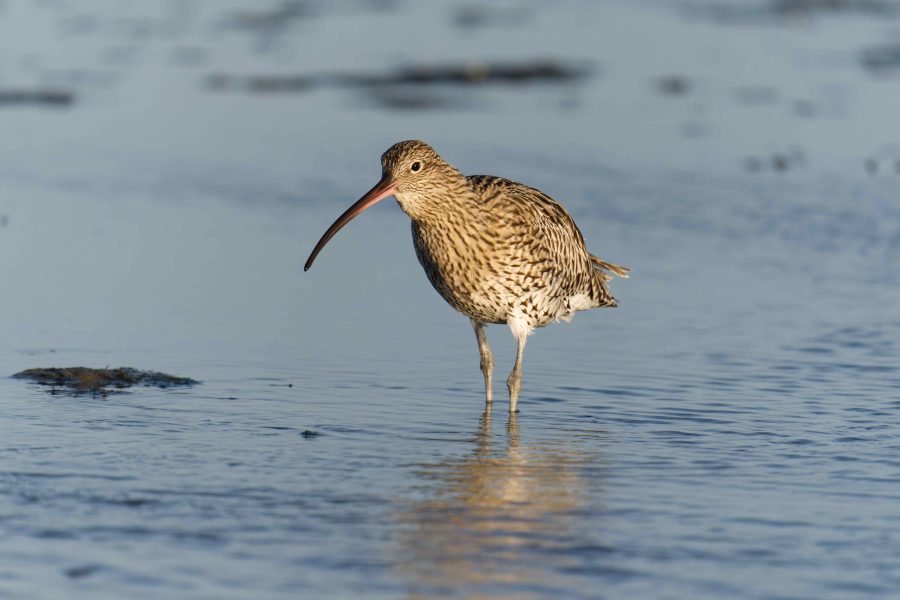The conservation project Curlew Country is live-streaming footage of a wild curlew nest this week offering viewers a chance to see the magical moment when the young of this rare and much-loved bird emerge from the egg.
The nest, situated in the borders of Shropshire and Montgomeryshire, is entering its final stage of incubation, in the next few days the three eggs will start pipping, a sign they are about to hatch.
‘Curlew Cam’ gives you an extraordinary insight into the secret world of nest life during the incubation and the hatching of the UK’s largest wader. Curlews breed in diverse habitats: moorland; heath; grasslands and farmland. Eurasian Curlews are territory faithful, returning to the same area year after year with both male and female incubating the eggs in shifts, dividing nesting duties. It takes approximately 28 days for the curlew to hatch, with parents feeding the chicks until they fledge around 36 to 50 days.
The Curlew is the herald of spring when it arrives inland to breed and makes its unmistakable bubbling call as part of its mating display and throughout the breeding season. If you listen, you can hear its range of calls on the Curlew Cam especially during changeovers or when responding to threats. Calls take on a different softer tone when adults call to the chicks, sometimes when still encased within the eggs near to hatching.

‘Curlew Cam’ offers an extraordinary insight into nest life
Our parent birds are no strangers to Curlew Country, this pair were previously the stars of Curlew Cam in 2022 when they nested in a neighbouring field. The male has been recognised by the Curlew Country initiative since he was colour ringed (identifying rings placed on the bird’s legs) in the local area five years ago. The female is un-ringed and less easy to monitor. They are nesting in a silage field and the nest is protected from most mammalian predators and agricultural activity by a temporary electric fence. Once the chicks arrive and are active they will leave this enclosure and will no longer be protected by either.
Curlew Country’s pioneering curlew recovery work in partnership with farmers and land managers has involved a number of UK firsts. Set up in 2017, Curlew Cam was the first ever live-streamed nest in the UK. While the camera provides an exciting opportunity to witness the rare insight into nest life, the impending arrival of these chicks is also a poignant reminder of the threat faced by the species. UK populations of curlew have declined by 50% over the last 25 years. It is a red-list species and considered to be the bird of highest conservation concern in the UK. Curlew Country’s fieldwork revealed that from all the nests monitored in the period 2015-2016, no chicks survived to fledge. In 2017 predation control and an agreement to compensate farmers for loss of crop were in place and chicks fledged successfully for the first time in two years.
Subsequently, in the absence of continued funding for farmers to support breeding curlew and strategic predation management, Curlew Country began a trailblazing technique known as head-starting. Head-starting is a method whereby eggs are taken under licence hatched elsewhere and returned to the landscape in which they started out. Since this unique Curlew work began, 129 chicks have fully fledged and have been returned to where they started. This is a last-resort method to try to prevent curlews from becoming extinct locally. With sufficient funding, natural nesting can be supported.
Tune in over the coming week and watch here: https://curlewcountry.org/curlew-cam/
To learn more about Curlew Country’s pioneering work go to: www.curlewcountry.org.uk
For more information contact curlewcountry@gwct.org.uk
More news like this can be found in The Country Smallholder magazine. Subscribe here.
For FREE updates from the world of smallholding, sign up for The Country Smallholder newsletter here.








